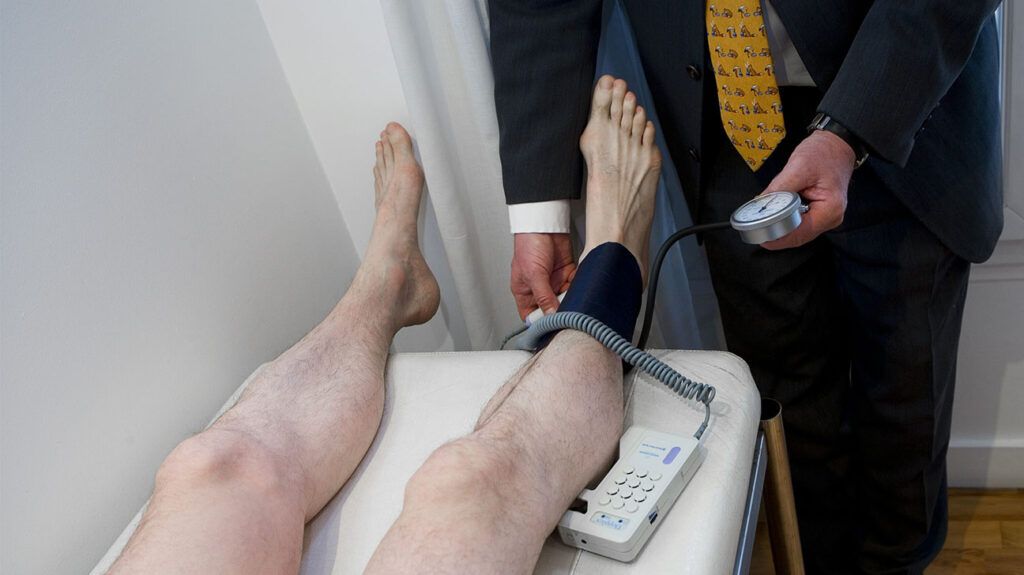Doctors screen for peripheral arterial disease (PAD) with an ankle-brachial index (ABI) test, which measures blood pressure in the legs. Experts recommend that anyone with PAD risk factors undergo screening.
Peripheral arterial disease (PAD) involves reduced blood flow in the arteries due to a buildup of plaque. This condition usually affects the legs and feet.
The first test doctors use to check for PAD is an ankle-brachial index (ABI) test, which they may follow with further diagnostic tests such as imaging tests to check how well the blood vessels are working.
This article looks at PAD screening and who should get it, other diagnostic tests, and PAD treatments.

Screening for PAD checks whether people may have the condition. A doctor might follow up with further testing to diagnose PAD.
Screening involves an ABI test that measures blood flow in the lower limbs. A doctor attaches a blood pressure cuff to the ankle and one to the arm. They also use an ultrasound to help measure blood flow.
A doctor takes both blood pressure measurements from the blood pressure cuffs and compares the leg measurement to the arm measurement.
The
- A score of 1.00 or above indicates that a person does not have PAD.
- A score below 0.90 at rest may indicate PAD.
- A score below 0.40 indicates severe PAD.
A doctor may perform a toe-brachial index (TBI) test instead of or in addition to an ABI test. A TBI test measures blood pressure in the big toe. A TBI score below 0.7 is an abnormal result.
When checking for PAD, a doctor may also take a medical history and assess any symptoms. They may do a physical exam to check for any problems in the legs or feet, such as swelling or a weak pulse.
The
A person may have an increased risk of developing PAD if they:
- smoke cigarettes
- have type 2 diabetes
- are 65 years old or older
- have a family history of PAD, cardiovascular disease, or stroke
- are Black
- have high blood pressure
If the results of an ABI test suggest that a person may have PAD, a doctor will carry out further tests to diagnose PAD. These
- Blood tests: These can check cholesterol and triglyceride levels and blood sugar.
- Exercise ABI test: This is the same as a regular ABI test, but a person walks on a treadmill before having the test. This can help a doctor check how severe the symptoms are and how physical activity affects the symptoms.
- Walking test: A doctor measures how far a person can walk in 6 minutes, which can help them check the severity of PAD and see how PAD affects function.
- Doppler ultrasound: A Doppler ultrasound uses sound waves to show how blood is moving through blood vessels. This can help doctors find any areas of restricted blood flow or blockages.
- Segmental Doppler pressure testing: This test involves using a Doppler ultrasound to measure blood flow at certain points in the legs, such as the thigh, calf, and ankles.
Diagnostic tests can help a doctor find out whether people have PAD, how severe the symptoms are, and how PAD is affecting function.
People can discuss their results with a doctor to understand what they mean and what a treatment plan may involve.
A doctor may order further tests to assess blood vessel health in the legs and feet or to check how well any PAD treatments are working.
Doctors
- computed tomography angiography
- magnetic resonance angiography
- catheter-based angiography
Treatment for PAD may depend on the person’s overall health and the severity of symptoms. The
- healthy lifestyle habits to support the heart
- regular exercise
- medications
- medical procedures to treat narrowed or blocked arteries
Treating and managing PAD
People can adopt certain lifestyle changes to help manage PAD, such as:
- getting regular physical activity, which may include walking and leg exercises
- quitting smoking, if applicable
- eating a heart-healthy diet, which is low in saturated and trans fats, salt, and added sugar and includes plenty of vegetables, fruits, and whole grains
- taking any medication as a doctor prescribes it
- managing diabetes with a treatment plan, if applicable
This section answers some frequently asked questions about screening for PAD.
What are 3 symptoms of peripheral arterial disease?
Three symptoms of PAD are:
- pain, heaviness, or cramping in the legs that comes on with physical activity but goes away with rest
- one foot or lower leg that is colder than the other
- reduced hair or toenail growth on the legs and feet
Who should get screened for PAD?
People who have any risk factors for PAD should undergo screening — especially those who smoke or have type 2 diabetes.
Being 65 years old or older, having high blood pressure, and having a family history of PAD are also risk factors for the condition.
What is the gold standard test for peripheral artery disease?
Computed tomography angiography is the gold standard test for PAD due to its accuracy, but other tests are also important in diagnosing PAD, such as ultrasound, treadmill tests, and MRI imaging.
People who have any risk factors for PAD should undergo screening. Early detection of PAD can allow people to start treatment earlier, which may help prevent the disease from progressing.
Screening involves an ABI test, which is a painless test to check blood pressure in the legs. Depending on the results, a doctor may order further tests to diagnose PAD or any other issues.
